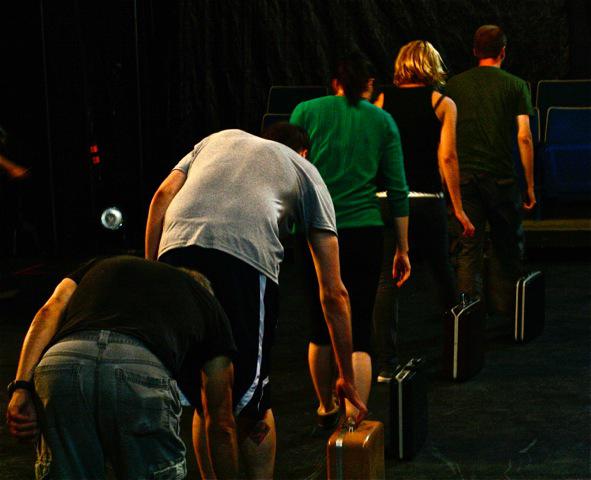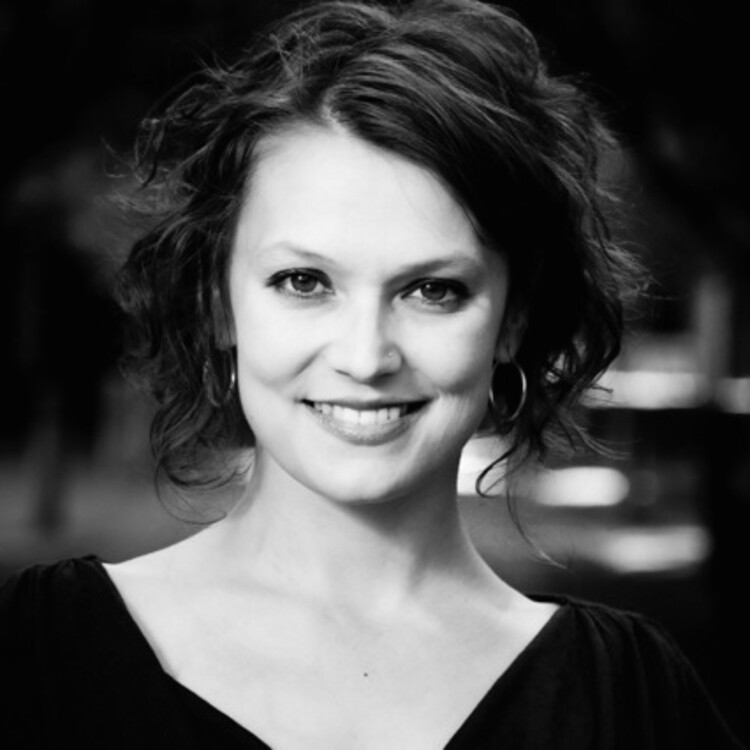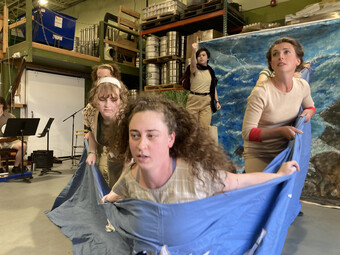More Love Affair than Assembly Line
Casting Practices in Devised Theatre
Devised theatre is, unquestionably, a unique beast—an ensemble coming together to create an entirely new collaborative work, emerging from the bodies and voices of the people in the room. But how do you figure out who should be in the room, making the work? With scripted plays, you have content (characters, monologues, attributes, etc.) from which to draw associations and comparisons. As a director, you may ask yourself: “Does this performer match my sense of that character?” But what do we do when characters have yet to be generated and text has yet to be written? Perhaps the question is more: “Does this performer match this way of working?” How do we determine this in a standard audition process?
There is an assembly line quality to the cattle call audition. Three to five minutes for each person, cycling in then out, through a seemingly rotating door. Without headshots and resumes we, as directors, would be completely lost—all those auditioning converging in a single Neil Simon monologue mishmash. “If you name an animal, you shouldn’t eat it,” or so the saying goes. No names for these folks. In an assembly line approach to auditions, much like industrial farming, it is easy to “slaughter” them.
Collaborative, devised processes demand a kind of communion of ensemble and director; performers cannot be cast on some dubious concept of “talent” alone. We will be embarking on a love affair—a meeting of the minds and aesthetic sensibilities.
Of course, I understand why this practices exists, when budgets and time are limited. When I am auditioning people for a devised rehearsal process, however, I am required to be much more artful and considerate than this industry standard. Collaborative, devised processes demand a kind of communion of ensemble and director; performers cannot be cast on some dubious concept of “talent” alone. We will be embarking on a love affair—a meeting of the minds and aesthetic sensibilities. The audition is our first date. Returning to my (also dubious) metaphor of the barnyard, I have to “name” them all.
I schedule a minimum of ten minutes with each performer. While this may sound exhausting, it is actually luxurious. The slower pace allows me a little time to breathe. I ask performers to prepare something they know very well—I am looking for texts that fit like a well-worn glove. I usually do not provide much additional information beyond that.
At the audition, with little instruction, they show me what they have prepared. As always, an auditioner who has prepared a text in advance provides valuable insight. The performer’s choices usually illustrate preconceived notions of the project, of the process and the content, and if the monologue is chosen well, it demonstrates the performer’s skills.
As soon as they finish their monologue, I start to play with them. I usually give them some kind of far-fetched direction, often something difficult, abstract, or intentionally obtuse. For example, I may have them stand as far away as possible and communicate to me as though I am across a great ocean. Or I will suggest that they speak the monologue while repeating a gesture in slow motion. Or perhaps if their content is angry or indignant, I ask them to lie on the ground, as though with a lover, and whisper it sweetly. It really does not matter what my direction is—it matters how they respond to it.
This allows me to assess a number of things, for example:
- How do they deal with disorientation?
- How fresh is the material? How much are they connected to the words in the moment or is the text too stale for them to respond to the new direction? Are they flexible? Are they more connected to the meanings of words than they are to the space, their body, and the moment?
- How do we communicate? Too often, communication between performers and directors is unidirectional. But directing is not so much how well one person speaks or another person listens, but what is the chemistry between the two. I have worked with brilliant people that somehow I can’t talk to—what I’m saying seems to come out as gibberish to their ears. I want to make sure we are speaking the same language and that they aren’t frustrated or befuddled by my direction and I am not feeling like I’m speaking underwater. I want to see if the performer will advocate for her or his understanding, asking clarifying questions.
- Sometimes by playing around with a performer’s material, it allows me to check for their preparedness for the audition. For instance, do they understand the work is physical or did they wear a miniskirt that won’t allow them to move freely? Can they physicalize the material on their own or with my prompts or are they, in spite of feedback, interminable talking heads?
- What is my interest in them? Do they keep feeding me ideas? Am I hungry to keep working with them? Do I have to select from a lot of ideas to give them more direction?
After we play a little, we sit down and have a chat. I always conduct mini interviews with the people who audition. I know that it is easy to screw up an audition, sometimes—or maybe especially—when you really want it. I have had tremendous success in taking enthusiasm and hunger over refined talent; some of my previous casting choices have dismayed colleagues. I like taking risks on people. And it is in these mini interviews that I can determine if the risk is worth it.

I am, again, looking for chemistry. I am also asking myself: Is this a responsible, compassionate person? Is this person curious? Do I like them? Do they seem interested in the work? I have usually already asked on the audition sheet why they want to do the work and what artists inspire them. This usually provides the fodder for these conversations. Additionally, the mini interviews allow the performers to interview me. They have the chance to ask me questions about the direction of the project, artistically and logistically.
Lastly, I make note as to whether they put away the chair or rehearsal block. This is a measure of their attentiveness to the space, their mindfulness, and their conscientiousness. I do not necessarily judge too harshly if they don’t put it back, but I do notice.
Second date: callbacks. The format for callbacks depends on the piece. If the show has a script or a framework for a script, I might distribute sides and see people in phases, pairing folks up, as per standard practice. In a devised piece, I usually call people back in groups and facilitate some work based on the anticipated themes of the show. In either case, I primarily consider callbacks an opportunity to gain insight and measure a performer’s interpersonal maturity. Again, I am generally looking for some synergy or communion. I watch as they interact with their peers, asking myself: are they generous? Can they take initiative? Do they balance a sense of will (making choices and asserting their ideas), with grace (giving in to the ideas of others and demonstrating a willingness to say yes)?
Finally, it’s time for me to figure out with whom I am ready to go steady. Having cultivated the information I feel like I need to make decisions, I call people. Yes, on the phone. I call the people from the callbacks that I don’t cast, to honor their work and give them an opportunity to ask me questions. It’s absolutely the most gut-wrenching part of the process. I have to rehearse each call I make. Though it is uncomfortable for me, I feel strongly that this is appropriate. I have generally asked people to share quite a bit of themselves by this point in the process and it seems like the decent thing to do to respond in-kind. But breaking up is always hard to do.
Embarking on a devised process is often a longer commitment than mounting a scripted play. I have followed this “process,” more or less, for the past ten years of directing. At the risk of sounding a bit too cheerleader-y for this way of auditioning, I can say that it works. With almost no exceptions, I have had the pleasure of directing multiple cohesive, compassionate, generous ensembles. I cannot recall regretting a casting choice or dealing with distracting interpersonal issues in the development of a show. Perhaps I’ve gotten lucky, but I think it’s because I truly fall in love with the artists I work with.
As I write this, I wonder: Is this conventional wisdom? Is this the criteria by which students and young artists are expecting to be evaluated? Are audition coaches and college instructors teaching these skills? Should they be?










Comments
The article is just the start of the conversation—we want to know what you think about this subject, too! HowlRound is a space for knowledge-sharing, and we welcome spirited, thoughtful, and on-topic dialogue. Find our full comments policy here
I know this is over 2 years old but thank you for this! I have a callback and although the pieces aren't devised, she said there may be some devising IN the callback itself as both pieces are very ensemble-based.
We just had our first auditions a few weeks ago for a devised production and followed a similar approach. It worked beautifully, and, sadly, made sending out rejections all the harder. We really got to know each and every one of the actors who walked through our doors (usually a problem for me who struggles to remember names).
Thank you for your insights. Your audition guidelines are extremely valuable.
Thanks for sharing your wisdom Julie! I especially connected to the passage about testing to see if they are speaking your language--that you sometimes feel like you're "speaking under water." That's a perfect characterization of what it feels like to be misunderstood or, in some cases, not trusted.
So often I've gotten a look or a question: "You want me to what?" Typically I repeat myself exactly, as I may have asked them to speak their text in a language they don't actually speak, or perform the piece with a stool as a lover. You've captured an essence of what it I may call testing someone's "play"fulness. Because devising often takes a lot of serious Playing with a capital P.
Thank you, Matthew and Jeff! I appreciate your kind words. And to your point, Jeff, YES. I was thinking that I missed an important point: that this can (should?), indeed, be a standard audition process (for a standard play). And two hours, Matthew? That's luxurious and awesome!
This is great, Julie. I love reading your articles. You're so very good at getting your thoughts out from between the polar oppositions that constrain so many of these conversations. Incidentally, I auditioned someone for a full two hours a few weeks ago before deciding to call them back. But we only audition a handful of people two or three times a year.
Very helpful, concise, clear guidelines. Nice job Julie! It's great to have such a strong explanation of what should become a standard process.